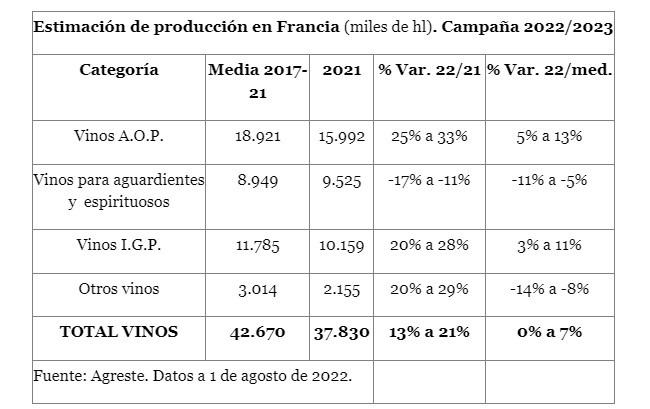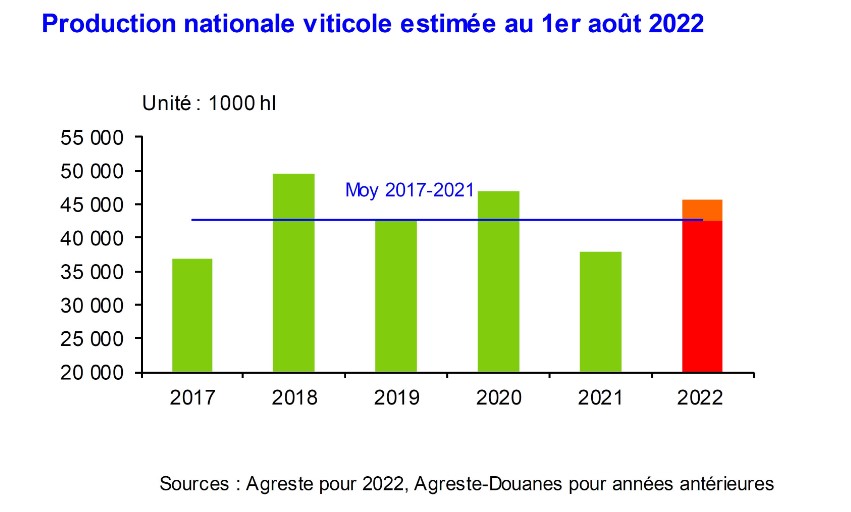
The first official estimate of wine production in France remains between 42 and 46 Mhl in the season 2022/23
The French Ministry of Agriculture presented on 9 August its first estimate of wine production, with data as of 1 August, with a processing range of 42.6 million hectolitres (at its lower end) and the 45.6 Mhl marking its upper end.
If this first forecast of Agreste is met, France would obtain a production higher than the (weak due to spring frosts) harvest of 2021 (13 to 21% more abundant), but that should be around similar figures or slightly higher than the recent five-year average (located at 42.67 MHz according to this statistical source).
However, it must be borne in mind that this is a preliminary estimate and that it will be refined in the coming months, since the bloody drought and, in some cases, the forest fires, may have an impact on the final production figures that permanent, therefore, still with a significant degree of uncertainty, in a vintage 2022 advanced in its cycle.
In 2022, the flowering of many vineyards took place under more favorable climatic conditions than last year. The spring frosts, followed by hail, mainly affected the vineyards of the south-west and Charentes, but at levels well below the severe damages suffered in 2021 in the Gaulish country.
Although in this first official estimate, Agreste has not published forecast data broken down by region, it does maintain that the conditions of the 2022/23 marketing year have favoured a higher production expected in all wine-growing areas, except for Charentes. However, the drought associated with heat waves, if prolonged until the harvest, could reduce this expected increase.
At the end of July, all vineyards showed advances in their cycle compared to 2021. Therefore, the harvest is also expected to occur in advance on the calendar.

Until the date of issue of this first report of Agreste, it was reported that, this year, unlike 2021, diseases are scarcer due to climatic conditions unfavorable to its development.
By category of wines, wines covered by some A.O.P. (equivalent to the Spanish D.O.P.s) will be the most important in volume, with a forecast (center of the fork) of 15.99 Mhl and a recovery of more than 25% compared to 2021. Next, wines under I.G.P., of which about 10.2 Mhl is expected, with increases of more than 20% compared to 2021. The wine destined for distillation should be around 9.5 Mhl (with losses of, at least 11% in its production); while the rest of wines will remain at about 2.16 Mhl (at least with a recovery of 20% compared to 2021, but far from the figures of the five-year average).

In Champagne, the frosts of April hardly affected the vineyard and they hoped to start harvesting at the end of August. The rains of June allowed a good recharge of the soil and the productive potential is above the five-year average.
Also in Burgundy, but drought can reduce yields, especially in the Beaujolais.
In Alsace, rainfall has been particularly low since spring and the average weight of the clusters is below the average weight of the last ten years, especially for the Gewürztraminer, Production is therefore expected to be below the five-year average.
In Savoia production is expected to approach the average of five years. In the Jura, the harvest looks promising in terms of volume, above average levels after the devastating frosts of 2021. Whereas, in the Loire Valley, an early harvest is expected. There were occasional frosts in April and hail in June, and drought could affect the decline in liquid grape yield. They should start harvesting in September.
In Charentes, the vineyard was affected by hail in June, along with the drought, will make the harvest in this area lower than 2021 and the five-year average.
In the Bordeaux region, frosts in April and hail in June affected the vineyard to varying degrees. As everywhere, the harvest is expected to be early, with harvesting work even in mid-August. Production is expected to fall short of the average volume.
In Languedoc and Roussillon, the first cluster cuts were already given at the end of July, production was expected to be slightly higher than the average five-year average, but could be revised downwards due to the drought that is affecting grapes, especially in the Roussillon and the Gard.
SOURCE: SEVI.NET
